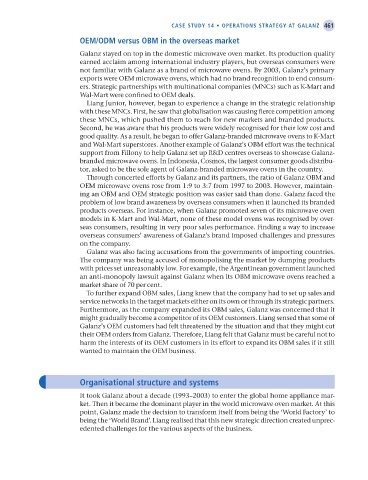Page 486 - Operations Strategy
P. 486
case study 14 • OperatiOns strategy at galanz 461
OeM/OdM versus OBM in the overseas market
Galanz stayed on top in the domestic microwave oven market. Its production quality
earned acclaim among international industry players, but overseas consumers were
not familiar with Galanz as a brand of microwave ovens. By 2003, Galanz’s primary
exports were OEM microwave ovens, which had no brand recognition to end consum-
ers. Strategic partnerships with multinational companies (MNCs) such as K-Mart and
Wal-Mart were confined to OEM deals.
Liang Junior, however, began to experience a change in the strategic relationship
with these MNCs. First, he saw that globalisation was causing fierce competition among
these MNCs, which pushed them to reach for new markets and branded products.
Second, he was aware that his products were widely recognised for their low cost and
good quality. As a result, he began to offer Galanz-branded microwave ovens to K-Mart
and Wal-Mart superstores. Another example of Galanz’s OBM effort was the technical
support from Fillony to help Galanz set up R&D centres overseas to showcase Galanz-
branded microwave ovens. In Indonesia, Cosmos, the largest consumer goods distribu-
tor, asked to be the sole agent of Galanz-branded microwave ovens in the country.
Through concerted efforts by Galanz and its partners, the ratio of Galanz OBM and
OEM microwave ovens rose from 1:9 to 3:7 from 1997 to 2003. However, maintain-
ing an OBM and OEM strategic position was easier said than done. Galanz faced the
problem of low brand awareness by overseas consumers when it launched its branded
products overseas. For instance, when Galanz promoted seven of its microwave oven
models in K-Mart and Wal-Mart, none of these model ovens was recognised by over-
seas consumers, resulting in very poor sales performance. Finding a way to increase
overseas consumers’ awareness of Galanz’s brand imposed challenges and pressures
on the company.
Galanz was also facing accusations from the governments of importing countries.
The company was being accused of monopolising the market by dumping products
with prices set unreasonably low. For example, the Argentinean government launched
an anti-monopoly lawsuit against Galanz when its OBM microwave ovens reached a
market share of 70 per cent.
To further expand OBM sales, Liang knew that the company had to set up sales and
service networks in the target markets either on its own or through its strategic partners.
Furthermore, as the company expanded its OBM sales, Galanz was concerned that it
might gradually become a competitor of its OEM customers. Liang sensed that some of
Galanz’s OEM customers had felt threatened by the situation and that they might cut
their OEM orders from Galanz. Therefore, Liang felt that Galanz must be careful not to
harm the interests of its OEM customers in its effort to expand its OBM sales if it still
wanted to maintain the OEM business.
Organisational structure and systems
It took Galanz about a decade (1993–2003) to enter the global home appliance mar-
ket. Then it became the dominant player in the world microwave oven market. At this
point, Galanz made the decision to transform itself from being the ‘World Factory’ to
being the ‘World Brand’. Liang realised that this new strategic direction created unprec-
edented challenges for the various aspects of the business.
Z14 Operations Strategy 62492.indd 461 02/03/2017 13:59

